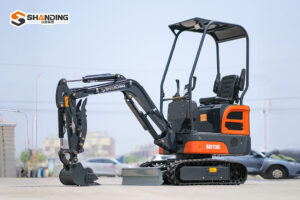With the continuous progress of urbanisation, the demand for various construction projects is also increasing, and small excavators, as a kind of efficient and flexible construction machinery, have become an indispensable part of construction projects. However, the complex terrain environment often brings great challenges to the operation of small excavators, so how do small excavators deal with complex terrain? Here we analyse through the actual case.
Case one
In a construction site, due to the more complex terrain, small excavators need to be in a steep hill for excavation operations. Due to the loose soil in the area, and the slope of the hill is large, which brings great difficulties to the operation of small excavators. In this case, we need to take the following measures:
1. Choose a suitable mini excavator
When carrying out hillside excavation operations, we need to choose a suitable mini excavator. Generally speaking, we should choose a small excavator with a large climbing capacity, which can better adapt to the terrain environment of the hillside. At the same time, the weight of the mini excavator should be moderate, not too heavy, otherwise it will cause too much pressure on the hillside.
2. Use the appropriate excavation device
In the hillside excavation operation, we need to use the appropriate excavation device. Generally speaking, we should choose the digging device with larger digging depth and smaller cutting force, so that it can better adapt to the soil environment of the hillside and avoid causing too much damage to the hillside.
3. Adopting appropriate operation methods
When carrying out hillside excavation, we need to adopt appropriate operating methods. Generally speaking, we should choose a small excavator with a large climbing capacity, and adopt the method of segmental excavation to gradually excavate the hillside down. At the same time, we also need to pay attention to control the digging depth and digging speed to avoid excessive damage to the hillside.
Practical Case II
In a construction site, due to the more rugged terrain, the mini excavator needs to carry out excavation work in a narrow valley. Due to the complexity of the terrain in the area, this posed a great challenge to the operation of the mini excavator. In this case, we need to take the following measures:
1. Selecting a suitable mini excavator
When carrying out excavation operations in the valley, we need to choose a suitable mini excavator. Generally speaking, we should choose small excavators with smaller size and higher flexibility, which can be better adapted to the terrain environment of the valley. At the same time, the weight of the mini excavator should be moderate, not too heavy, otherwise it will cause excessive pressure on the valley.
2. Use the appropriate excavation device
In the valley excavation operation, we need to use the appropriate excavation device. Generally speaking, we should choose the digging device with smaller digging depth and larger cutting force, which can better adapt to the soil environment of the valley and improve the digging efficiency.
3. Adopt appropriate operation method
When excavating in the valley, we need to adopt appropriate operating methods. Generally speaking, we should choose a small excavator with high flexibility, and adopt the method of segmental excavation to gradually excavate the valley. At the same time, we also need to pay attention to control the digging depth and digging speed to avoid excessive damage to the valley.
Through the analysis of the above two real-world cases, we can see that when dealing with complex terrain, small excavators need to choose the right small excavator, use the right digging device and adopt the appropriate operating method. Only in this way can we better adapt to the complex terrain environment and improve the digging efficiency, while also protecting the environment and avoiding excessive damage to the terrain.




